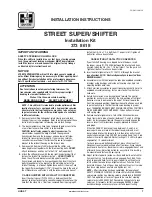
•
The
Driver and Passenger Airbag/Inflator Units
are
located in the center of the steering wheel and the right
side of the instrument panel. When the ORC detects a
collision requiring the airbags, it signals the inflator
units. A large quantity of nontoxic gas is generated to
inflate the front airbags. Different airbag inflation rates
may be possible based on collision severity. The steer-
ing wheel hub trim cover and the upper right side of
the instrument panel separate and fold out of the way
as the bags inflate to their full size. The bags fully
inflate in about 50 - 70 milliseconds. This is about half
of the time it takes to blink your eyes. The bags then
quickly deflate while helping to restrain the driver and
front passenger. The driver’s front airbag gas is vented
through vent holes in the sides of the airbag. The
passenger’s front airbag gas is vented through vent
holes in the sides of the airbag. In this way the airbags
do not interfere with your control of the vehicle.
•
The
Side Impact SRS Window Bags
are designed to
activate only in certain side collisions. When the ORC
(with side impact option) detects a collision requiring
the window bags to inflate, it signals the inflators on
the crash side of the vehicle. A quantity of nontoxic gas
is generated to inflate the window bag. The inflating
window bag pushes the outside edge of the headliner
out of the way and covers the window. The airbag
inflates in about 30 milliseconds (about one quarter of
the time it takes to blink your eyes) with enough force
to injure you if you are not belted and seated properly,
or if items are positioned in the area where the
window bag inflates. This especially applies to chil-
dren. The window bag is only about 3-1/2 inches (9
cm) thick when it is inflated.
•
The
Knee Impact Bolsters
help protect the knees of
the driver and the front passenger, and position every-
one for the best interaction with the front airbag.
56
THINGS TO KNOW BEFORE STARTING YOUR VEHICLE
Summary of Contents for 2007 Durango
Page 2: ......
Page 6: ...6 INTRODUCTION...
Page 104: ...104 UNDERSTANDING THE FEATURES OF YOUR VEHICLE...
Page 105: ...UNDERSTANDING THE FEATURES OF YOUR VEHICLE 105 3...
Page 106: ...106 UNDERSTANDING THE FEATURES OF YOUR VEHICLE...
Page 183: ...INSTRUMENTS AND CONTROLS INSTRUMENT PANEL AND CONTROLS 183 4...
Page 184: ...Instrument Cluster 184 INSTRUMENT PANEL AND CONTROLS...
Page 244: ...Operating Tips Chart 244 INSTRUMENT PANEL AND CONTROLS...
Page 292: ...292 STARTING AND OPERATING...
Page 342: ......
Page 360: ...ENGINE COMPARTMENT 3 7L V6 360 MAINTAINING YOUR VEHICLE...
Page 361: ...ENGINE COMPARTMENT 4 7L V 8 MAINTAINING YOUR VEHICLE 361 7...
Page 362: ...ENGINE COMPARTMENT 5 7L HEMI V 8 362 MAINTAINING YOUR VEHICLE...
Page 399: ...MAINTAINING YOUR VEHICLE 399 7...
Page 410: ...2 Rotate the light to the outboard side of the vehicle and remove 410 MAINTAINING YOUR VEHICLE...
Page 420: ......
Page 446: ......
Page 456: ......
Page 457: ...INDEX 10...
















































